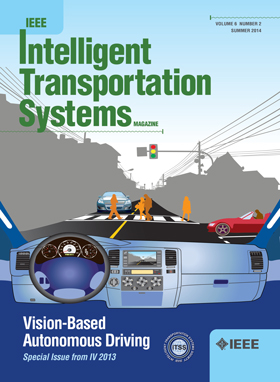A Task-Oriented Spatial Graph Structure Learning Method for Traffic Forecasting
IF 7.9
1区 工程技术
Q1 ENGINEERING, CIVIL
IEEE Transactions on Intelligent Transportation Systems
Pub Date : 2025-02-14
DOI:10.1109/TITS.2025.3537637
引用次数: 0
Abstract
Traffic forecasting is the foundation of intelligent transportation systems (ITS). In recent, graph neural networks (GNNs) have successfully captured spatial-temporal dependencies to forecast traffic conditions by transforming traffic data in the graph domain. Nevertheless, the existing methods focus only on learning informative graph representations and fail to model informative graph structures, which hinders the capture of dynamic spatial-temporal dependencies caused by dynamic factors such as weather, accidents, and special events. In this paper, we propose a novel task-oriented Spatial Graph Structure Learning (SGSL) method, which aims to capture dynamic dependencies by jointly learning graph structures and graph representations. Compared to methods that use spectral graph representations, we exploit a learnable spatial graph to effectively model dynamic dependencies in traffic data. Moreover, we directly define graph convolutions on spatial relations to specify different edge weights when aggregating the information of spatial neighbours. Thus, the graph structure alterations, i.e., the relation changes, and the time-varying weights of relations can be encapsulated, thereby effectively representing dynamic dependencies. The gradient descent strategy is introduced to periodically learn a spatial graph through joint optimization with a newly designed deep graph learning model named GAT-nLSTM. In this manner, the intrinsic behaviours of nodes are learned to capture correlations across periods. Notably, the optimization process is performed under the traffic forecasting constraint to ensure that the learned spatial graph is specific to this task. Compared with those of state-of-the-art baselines, the experimental results obtained on real-world traffic datasets show significant improvement, which verifies the superiority of the proposed SGSL.面向任务的交通预测空间图结构学习方法
交通预测是智能交通系统的基础。近年来,图神经网络(gnn)通过转换图域中的交通数据,成功地捕获了时空依赖关系来预测交通状况。然而,现有的方法只关注于学习信息图表示,而未能对信息图结构进行建模,这阻碍了捕获由天气、事故和特殊事件等动态因素引起的动态时空依赖关系。本文提出了一种新的面向任务的空间图结构学习(SGSL)方法,该方法旨在通过联合学习图结构和图表示来捕获动态依赖关系。与使用谱图表示的方法相比,我们利用可学习的空间图来有效地建模交通数据中的动态依赖关系。此外,我们在空间关系上直接定义图卷积,在聚合空间邻居信息时指定不同的边权。因此,图的结构变化,即关系的变化,关系的时变权重可以被封装,从而有效地表示动态依赖关系。引入梯度下降策略,与新设计的深度图学习模型GAT-nLSTM联合优化,周期性学习空间图。通过这种方式,学习节点的内在行为来捕获跨时间段的相关性。值得注意的是,优化过程是在交通预测约束下进行的,以确保学习到的空间图是特定于该任务的。在实际交通数据集上的实验结果表明,与目前最先进的基线相比,该方法有了明显的改进,验证了该方法的优越性。
本文章由计算机程序翻译,如有差异,请以英文原文为准。
求助全文
约1分钟内获得全文
求助全文
来源期刊

IEEE Transactions on Intelligent Transportation Systems
工程技术-工程:电子与电气
CiteScore
14.80
自引率
12.90%
发文量
1872
审稿时长
7.5 months
期刊介绍:
The theoretical, experimental and operational aspects of electrical and electronics engineering and information technologies as applied to Intelligent Transportation Systems (ITS). Intelligent Transportation Systems are defined as those systems utilizing synergistic technologies and systems engineering concepts to develop and improve transportation systems of all kinds. The scope of this interdisciplinary activity includes the promotion, consolidation and coordination of ITS technical activities among IEEE entities, and providing a focus for cooperative activities, both internally and externally.
 求助内容:
求助内容: 应助结果提醒方式:
应助结果提醒方式:


